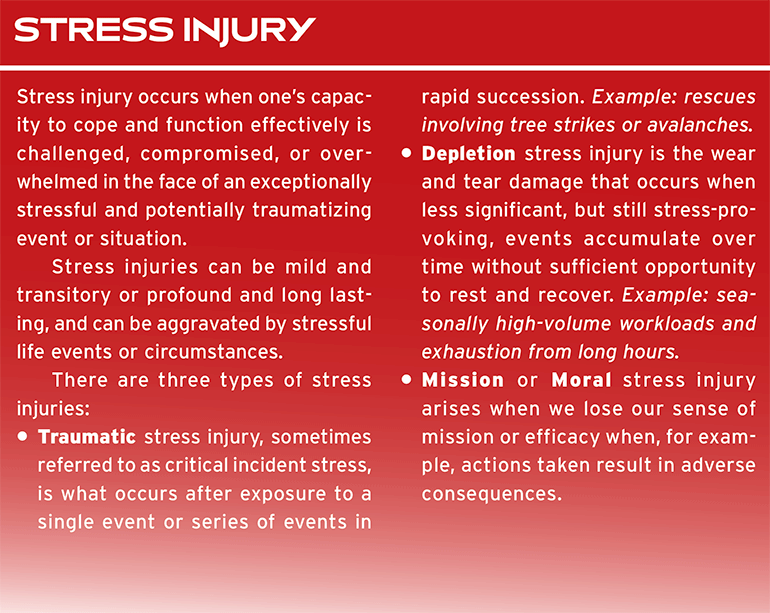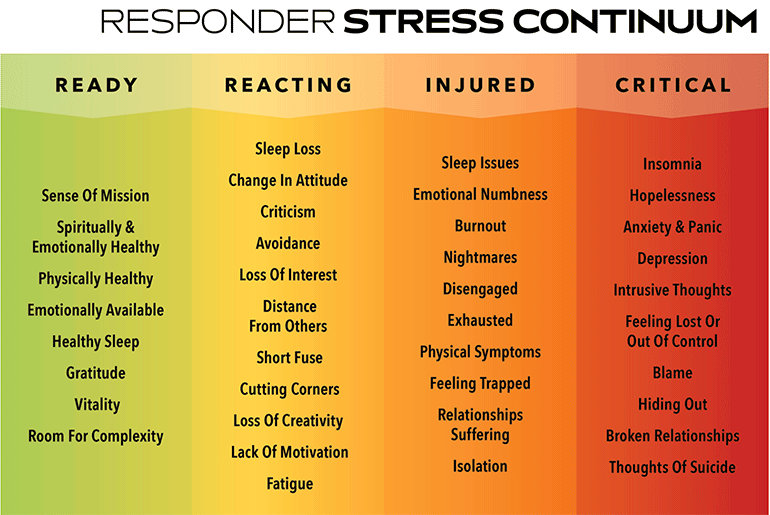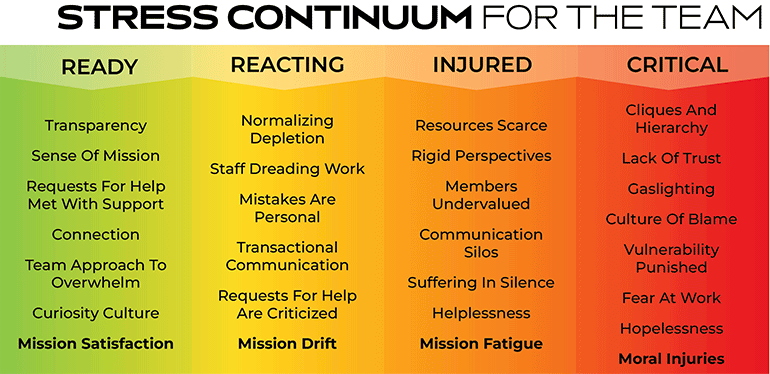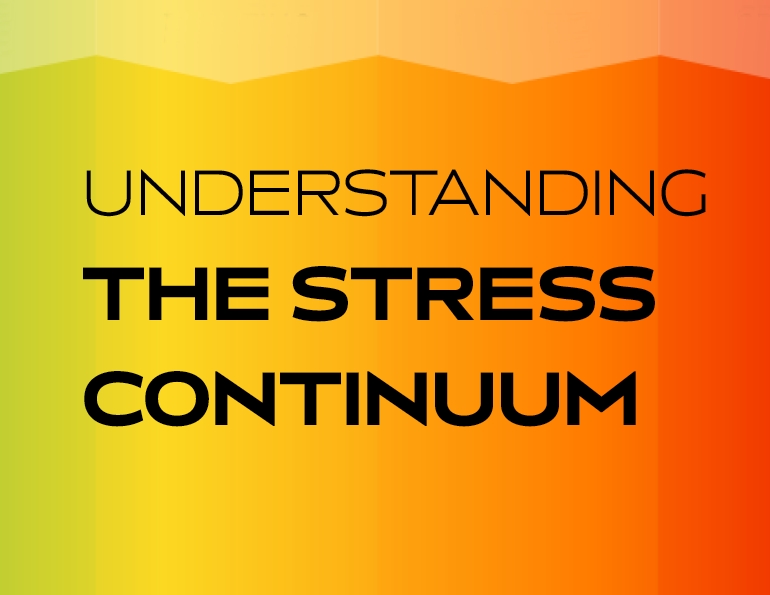Mountain resorts can be tough, stressful places to live, and the lack of access to mental health services takes its toll. Resorts have become increasingly concerned about the well-being of employees, especially their mental health and psychological resiliency. Yet proven, scalable programming to address this concern is sorely lacking, except in the case of some ski patrols—whose experience holds lessons for other departments as well.
Employee retention is often the impetus for addressing mental health issues. The costs associated with recruiting and training new personnel far outweigh those associated with support measures that encourage employees to stay on the job. Elly Orszulak, director of guest relations at Eldora Mountain Resort, Colo., cites an additional motivation: “After 15 years in ski industry leadership, I have learned that creating a culture of supporting employees results in happy guests.”
For both these reasons, Zach Ryan of the Eldora ski patrol believes that resorts want to be seen “as supporting the growing attention being paid” to mountain community mental health in general. Ryan has worked with multiple resorts as a representative of the Responder Alliance, which aims to focus attention on stress injury and recovery nationwide.
First responders first to change. To date, much of this work has been done with ski patrols. Across the U.S., from the Pacific Northwest to New England, ski patrols have developed peer support programs, now more commonly referred to as resiliency teams.
In Colorado, where the suicide rate is among the highest in the nation, Eldora ski patrol has been at the forefront of the movement. Their resiliency team development plan includes training on stress injury (see below) and psychological first aid for both the rescued and the rescuer.

THE INDIVIDUAL RESPONDER STRESS CONTINUUM
Originally developed by the armed forces, the stress continuum provides the conceptual model for resiliency teams in a range of occupations. It was adapted by Laura McGladrey, founder of the Responder Alliance, to create a Responder Stress Continuum (see graphic, below).

The continuum's “color-coded pain scale,” says McGladrey, was first conceived as a tool to provide first responders, including ski patrollers, with a dynamic framework for understanding post-event reactions—that is, what happens emotionally, cognitively, and psychologically after exposure to traumatizing events.
The continuum also furnishes patrollers with a common language to name and talk about what happens to them after a particularly bad scene. In McGladrey’s view this is critical. “There’s something important about naming it,” she says. “Once you can name it, you can recognize it, you can start to heal. If you can’t name it, it feels like it’s just something wrong with you.”
Grading stress. The yellow/Reacting column lists some of the more common and relatively mild reactions that can occur when coping mechanisms are challenged. The orange/Injured column shows more serious repercussions of compromised coping capacity. The red/Critical column lists the signs and symptoms of overwhelm—the state of being overpowered by stressful stimuli to the point of losing, at least temporarily, the ability to rebound and recover.
The dynamism of this model is illustrated in the increasing severity of reactions. Notice how sleep loss develops into sleep issues to full blown insomnia or how avoidance of others evolves to disengagement to hiding out.
The value of being green. It’s important to note, however, the continuum’s green/Ready column. This is the state of being prepared to deal with whatever may come along, like having a full charge in one’s coping battery.
The “Ready” state is achieved by leveraging the behaviors and attributes that can be employed to formulate individual resiliency plans to mitigate stress injury. These green choices are positive actions people can take to help themselves move back toward “Ready” status when they may have migrated to yellow or beyond.
Eldora patrol's customized stress continuum. Recently, patrollers at Eldora customized the continuum to create one specific to their crew (see below).

Through hours of discussion and consensus building, Eldora’s patrollers named the behaviors, beliefs, and attitudes that describe how they exhibit healthy readiness or stress injury—how they know when they themselves or another patroller is in the yellow, orange, or red. It provides a non-clinical, non-threatening, non-stigmatizing and normalizing way to share and connect.
And it describes the green in ways everyone can relate to.
This example demonstrates how teams can adapt the stress continuum model to their particular culture.
THE TEAM STRESS CONTINUUM
Like individuals, groups of rescuers also react to traumatic, depletion, and mission stress in a dynamic and predictable manner. The Team Stress Continuum reflects this thinking (see below).

This continuum arrays what a team “looks like” when it’s healthy and ready to respond: members are connected, share a sense of mission, and know that mutual support is the norm. Likewise, an injured team will be characterized by a sense of helplessness, a culture of suffering in silence, and lack of trust.
The Eldora ski patrol is in the process of building a team continuum, which, like the individual continuum, is specific to them.
UP NEXT: RESORT-WIDE RESILIENCY TEAMS
Eldora's big vision. Most recently, Eldora has begun to look into how the continuum model can be adapted beyond the ski patrol for use in developing a resort-wide resiliency team. While in the very early stages of carefully crafting a “trail map” for moving forward, Eldora is starting from a recognition that stress injury significantly impacts employee performance, job satisfaction, and mental health.
Of course, non-patrol staff are not insulated from exposure to traumatic events. As Orszulak notes, “The mountain is in many ways its own small community. More often than not, if there’s an accident on the mountain, an employee was either a witness or an acquaintance or a friend of the person(s) involved.” So, they, too, can benefit from learning how traumatic events may affect them.
But more often, depletion is the source of “wear and tear” stress injury for guest services and mountain operations staff or ski instructors and parking lot attendants. These customer facing employees routinely deal with angry and upset guests who can, at times, be abusive and even threatening.
Also, the staffing shortages common to resorts today mean that employees at all levels and in all departments must assume bigger workloads, increased responsibilities, and longer hours.
Building on the work of the patrol, Eldora hopes to teach the individual stress continuum to ski instructors, guest services staff, and other employee groups. The goal is to provide information and tools that employees can use to identify and mitigate traumatic as well as depletion stress injury.
"It is also the responsibility of employees to learn as much as they can about supporting themselves and their colleagues from foreseeable stress impact,” says McGladrey. “Both employer and employee have much to gain by sharing this responsibility and the innovative tools for recognizing and mitigating stress early.”
Creating buy-in. Understanding that not everyone will be invested in this project, the intent is to seek volunteers and, as more and more employees learn about stress injury and its effects, eventually gain more buy-in over time.
Eldora anticipates that by this time next year, a number of Team Stress Continuums, like the one shown at right, will have emerged to demonstrate what a stress-injured guest service or ski instructor team look like, and show how team members can work back to green.
One of the challenges for each department is the likely greater emphasis on depletion stress related to the specific department and naming the reactions that best illustrate it.
It's possible that some departments may adopt ski patrol processes, like daily personal readiness assessments, and/or green-maintaining rituals, like social gatherings.
More and more resorts are recognizing the importance of providing staff in all departments with tools to address stress injury, too. "Many times this year I've gotten calls to support ski school, parking, adaptive skiing, and lift operators after tragic events," says McGladrey. "Stress, both cumulative and acute, affects everyone in the ski industry."
MANY SOURCES, ONE GOAL
Much of the resiliency planning being done in the West—at resorts like Monarch, Colo., Mt. Ashland, Ore., and Jackson Hole Mountain Resort, Wyo.—relies on the work of the Responder Alliance. But there are many resources available that resorts are leveraging for their ski patrols, which could evolve into resort-wide programs.
For example, in the East, the Camelback, Pa., Disruptive Event Response Team (DERT), a pioneering peer support program, has its origins in the Mitchell Model and the International Critical Incident Stress Foundation. At Sunday River, Maine, patrollers are working closely with the All Clear Foundation. And a newly established program at Gunstock, N.H., has been supported by the Patroller Stress Awareness Team (PSAT) of the National Ski Patrol’s Eastern Division.
Starting from different places, each of these efforts is pursuing the same goal: finding better ways to help patrollers take care of themselves and each other.
MOVING UPSTREAM
Drew Petersen, a pro skier and mental health advocate who has spoken at events across the industry, hopes resorts can help their communities address the dearth of mental health resources available to all resort town dwellers. “Maybe we need to move the search for solutions upstream,” he says.
Resiliency teams are just such an upstream solution. They provide a means to address stress injury formation proactively, rather than waiting to be surprised by an overwhelming event or being silently worn down by depletion stressors.
If resiliency teams can do this for resorts, can the model also be applied, as a public health measure, to entire resort communities?
IT’S ALL ABOUT CONNECTIONS
Resiliency teams work because they harness the power of community—the power of social connection—to nourish and sustain better ways for people to take care of each other before crises develop.
To paraphrase McGladrey: We know from the literature that the single most important factor in how injured you will be after you suffer stress injury—be it traumatic, depletion, or mission-related—is your level of social connectedness.
This means that it matters if other people know you, care about you, and have a sense of how you’re doing.
Creating teams (and communities) that folks can rely on when hard things hit might be the single most important thing we can do to mitigate stress injury.






